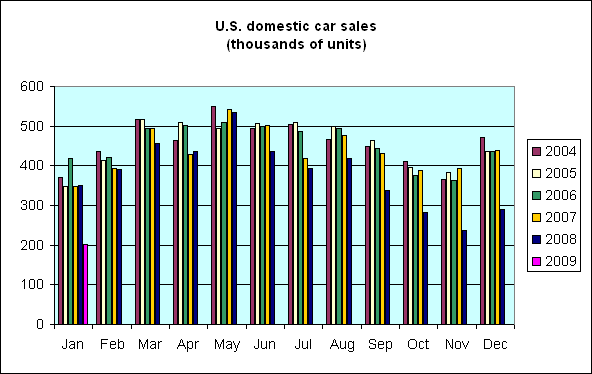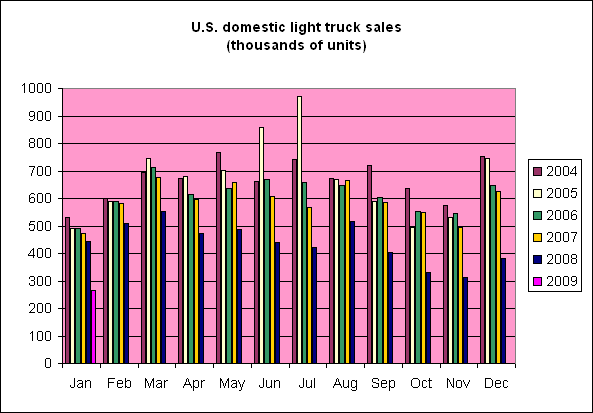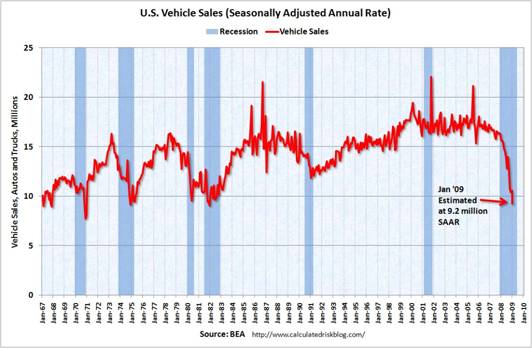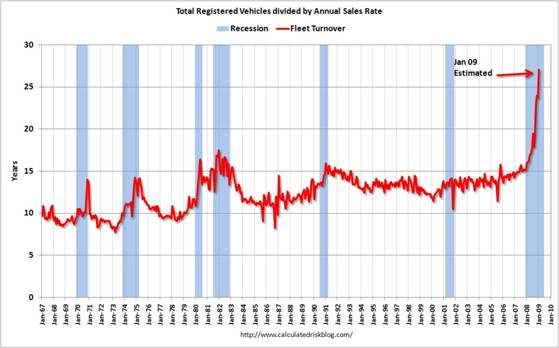Dreadful as 2008 was for the U.S. automakers, 2009 is starting out even worse.
I was greatly concerned when it was reported that Americans bought only 236,000 domestically manufactured cars in November. But January’s figure of 202,000 was 14% below even the November number, and down 42% from January 2008.
 |
Same story with domestic light trucks– down 15% from November and 40% from January 08.
 |
Calculated Risk estimates that January’s sales of all light vehicles (domestics and imports) will be reported as 9.2 million units at a seasonally adjusted annual rate, the lowest level in a generation.
 |
But CR does another calculation that gives him some hope, which I’ve tried to reproduce (perhaps imperfectly) as follows. There were 247.3 million motor vehicles registered in the United States in 2007. That number seems to include vehicles such as tractors and heavy trucks, but light vehicles are by far the most important component. If we take the ratio of that total to the annual sales rate, we get

Such a ratio can’t possibly be sustained– a typical car can hardly last 27 years, and the current value is way out of line with what the number is calculated to be at other available dates. That– plus the fact that just a few years ago, Detroit was selling twice as many light vehicles as it is today– should give us reason to see the potential for a huge rebound in vehicle sales.
 |
But the question is, will GM and Ford still be around to produce them and sell them?
Technorati Tags: macroeconomics,
autos,
auto sales,
economics,
recession
Interesting point about the sales ratio vs. needed replacement. I hadn’t really thought of that. Well, perhaps we have something to look forward to in future retail sales and GDP figures 18-months to 2 years from now
All the more reason that the recession will be ending by August or so. Every time there was a deep plunge, it coincided with the final months of the recession.
Note how even before the recession, the number of vehicle sales was not rising at the same rate as the US population. It seems to be that vehicle unit sales grow slower than the population. This is proof that vehicles are lasting longer due to technological advancements. We can expect this to continue.
It strikes me as misleading to compare the stock with the monthly flow, more misleading than inventory sales for homes because there at least the stock consists of homes “for sale” as opposed to “in existence.” It would be more interesting (though I am sure harder to find) to know the age distribution of the U.S. fleet. Presumably it has changed far less than the ratio plotted by CR and you.
Related to our economic environment, a fascinating statement about the SEC and the Madoff Ponzi crime :
http://www.calculatedriskblog.com/2009/02/markopolos-testimony-to-congress-on.html
As the population level is 306 M (Population clock), and that includes children, there is surely a fair amount of slack that can be accommodated in the number of registered vehicles.
Anonymous: That’s why the monthly number is quoted at an annual rate for this calculation– please study the units in the equation provided.
JDH: “Such a ratio can’t possibly be sustained”
I agree there is a force pulling the ratio back into equilibrium, but like purchasing power parity, the value/growth spread in equities, uncovered interest parity, the rental/price ratio in real estate, etc the disequilibrium may persist for a *long* time. Cars in Cuba and Myanmar, for example, have been made to last a very long time. I’m not suggesting we are there, but if the recovery is a sufficiently wide U, or worse, an L, then people may postpone purchases for a long time, and just do more maintenance.
I am not sure if there is better data available but the simple calculation that yielded 26.9 doesn’t cut it. We need to know the distribution of the current age of the installed base of cars. I’d expect the base to skew recent, esp. the last few years (the boom years) so 26.9 is much higher than the real number.
Doesn’t this just say that sales before the downturn were not a bubble – that purchases were roughly in line with population growth plus replacement levels? The question then seems to be whether the trend is for the existing base to move downward as the country moves towards a lower-leverage lifestyle with fewer capital goods. My guess is not – the number of cars may decline slightly per capita over the next decade (although buyers will likely buy cheaper cars). So I’m ending up at te same place – a rebound in sales numbers in a couple of years.
Regarding the last graph…
What should it look like? Flat or upward sloping, given population growth, mass transit, the green movement, quality improvements, increase in the number of collector or antique cars.
It should be upward sloping. T
he big three have been able to cut production so they oversold cars for the past 10 years, now the slope is catching up to were it should be.
In Cuba, they still drive cars made in the 1950’s! The auto or SUV as a status symbol is dead.
I meant to type that the big three have been unable to cut production.
The sharp declines shown in CR’s recent charts, and a column by FT’s Lucy Kellaway about the internet’s power to feed anxiety on a global scale should raise the question of whether this recession is accelerating at unprecedented internet speed. If it’s not coincidence that the first all-hemispheres recession is occurring when the internet has finally been adopted worldwide, then the rebound might surprise everybody and be a simultaneous moon-shot, or, at any rate, happen a lot faster than the grinding pace most economists and policymakers seem to be bracing for.
Wishful thinking by you and CR, Professor.
The ratio of vehicles to population will plunge as household size increases. In this now underway depression, parents will be moving in with children and children will be moving in with parents. Such is probably already happening, given the increase in home vacancies reported last week.
Household debt to GDP is at unseen-before levels. People are rationally slashing any and all unnecessary outlays, such as replacing that third vehicle when it goes T.U. or gets too expensive to repair.
Where I grew up (Texas), one just puts the dead vehicle up on cinderblocks in the front yard.
Why, I don’t know, but that seems to be the custom.
Probably soon coming to California.
CR also noted that the replacement ratio could be resolved in two general ways: “This could happen with vehicles being removed from the fleet, but more likely because of an increase in sales.”
The problem is that both are possible. While there will be an increase in sales at some point, there may be a reduction in motor vehicle *registrations* for a time as well. After all, how many housing contractors need their full-size pickups while they’re unemployed? As far as I know you only need to pay for a registration if you plan to drive the thing. Why bother to keep the license plate if you don’t need to drive it?
The FHWA has registration history back to 1900. You can find that information at http://www.fhwa.dot.gov/ohim/summary95/section2.html. Registrations rose continuously from 1900 to 1929, then fell from 1929 to 1933, rose again from ’33 to ’37, fell a bit in ’38, rose until ’41, fell from ’41 to ’44, and rose thereafter.
That’s a pretty simple to understand pattern. Registrations rose until the market crash, fell until the recovery started in ’33, fell again when FDR tried to cut off stimulus in ’37-’38, rose until WW2, fell during the war, and rose after that.
I.e. if this recession is really bad enough to compare to the Great Depression, we shouldn’t be surprised if registrations actually fall. They did in the Depression. If we can find sales figures going back that far, we can extend CR’s chart back to the Depression, and see what happened then. We might see a familiar pattern.
If you look at 1979-1982, it looks like people tried to squeeze 60% more useful life from their vehicles – from a base of 10 years. If you believe vehicles are better quality and last longer now, which seems reasonable, we are now seeing people try to squeeze 70% more useful life from their vehicles, from a base of 14 years, in the current recession. Some rebound in car sales seems like a reasonable medium-term prospect, but I’d point out that vehicle financing on a pre-2008 level isn’t coming back, which will damp the rebound.
How are sales of scooters, bicycles and shoes?
We’ve been living too Too Much Car for a while. People would get their lease car replaced every few years. Or would have 3 cars when 2 would do, (or 2 cars when 1 would do).
I agree that sales will not stay this low, but I could easily it being a long time before we get back up to our old levels.
The bad news for me is that there will be less people willing to pay for the depreciation of the first few years, leaving me with a nice used car to buy.
rebuilt the engine in my 97 car two years ago, expect to get another 10 to 12 years of life from it. Many others folks will buy a good used vehicle given the large number around. Auto sales will probably never come back to 2007 levels!
And this is why I love Econbrowser. To the point and with a new angle. Didn’t look at it that way, thanks Prof (and CR)!
27 years sounds like a long time, but isn’t there significant room in that figure for many cars to simply not be replaced and the number of cars/person to drop?
e.g. Retirees with decimated investments downsizing to one car, no home equity means no car for the highschooler or kid away at college, younger urban couples making do with one or no cars for both financial and environmental reasons.
The recent big reduction in miles driven also goes a long way towards making cars last.
Unit sales don’t tell the whole story. One of the biggest adjustments is that people who were once in the market for a $50K car are now buying $25K cars, but the unit count is the same.
Also, people saving money on cars (a depreciating asset) to pay down debt is not a bad thing.
Lastly, it will speed up the technological advances in cars. You will see 2011 model cars with vastly better electronic features than 2009 model cars.
One other benefit : Fewer teenagers will be allowed to drive the car, and fewer still will be bought their own car.
Hence, there will be less traffic, fewer accidents (since drivers 16-19 cause a disproportionate number of accidents), and also somewhat fewer teen pregnancies.
“The bad news for me is that there will be less people willing to pay for the depreciation of the first few years, leaving me with a nice used car to buy.”
I used to think that, but do you really want to sit on a seat that someone else sat on for 3-4 years, passing gas all that time?
ron,
How much would it cost to rebuild an engine on, say, a Honda Civic? It is something I want to seriously consider.
In a recent phenom, many car buyers are underwater on their current car. They used to have trade in value to put toward the new car. Now they don’t.
The resale market for gas hog used cars has tanked. People cannot get fair value by selling them, so they keep them.
Plus people don’t want the current gas hogs. They are waiting for Detroit to market the higher mileage vehicles.
Car sales have always nose dived during oil shocks. People have a transportation budget. The money they pay for fuel does not go to new car purchases.
As someone mentioned, the 2nd or 3rd car does not get replaced. The gasoline is not affordable so people drive less and need their car less.
Plus credit is hard to get. Many potential buyers cannot get financing.
Cars are really expensive to maintain.
ALl these things have created a perfect storm.
Even so, auto sales should not return to previous levels. Why sell cars at prices that are not profitable? The Big 3 need to “right size” their production to a lower number that requires them to give fewer incentives to purchase.
The auto data is clearly anomalous, and coincides broadly with the collapse of Lehman. Put me down for a sharp rebound, relatively soon.
There is no reason that your average Hummer H2 can’t last damn near forever. Full frame SUVs are near indestructable. Tahoes, Explorers, and the like. The engines are really cheap to replace, too.
So… a 27 year replacement rate? Why not?
Very nice data-driven points, KJMC-.
In a recent phenom, many car buyers are underwater on their current car. They used to have trade in value to put toward the new car. Now they don’t.
Most everyone was always underwater on their car loans. The looseness of the secured asset was (part of) what made car loans more expensive than home loans.
The real sea change over the past five years or so was that car dealers would roll the negative equity on an owner’s previous car into the loan for their new car. Repeat this a few times and you have people getting 30K and 40K loans on $25,000 cars.
That game may have been the only thing propping up Detroit, and its popping is one reason Detroit is hurting so bad right now.
I feel better now as it appears that my 19 year old volvo has at least another 7.9 years left in it.
I used to work at one of the Japanese automakers until recently. I can tell you that it is true that dealers often took in cars with car loans still on them, and rolled the excess debt onto a new loan. They would even throw a cash sum on top from what I heard. This was much more prevalent in the truck market than the car market. Trucks also have worse residual value than cars on the whole, so repeat truck buyers got into a hole that much faster.
I agree that there will be a shrinkage in the overall vehicle population, but I don’t think it will be drastic in the long term. I live in the South, and every city I’ve lived in down has negligible public transportation. Everything is so spread out that not owning a car means severely reduced access to the local job market and services. I tried to get away from owning a car. I rode my bike to work for a year. Then I got hit by a car.
So what does all this babbling mean? Until there is widespead light rail across the country vehicle demand in inelastic and will remain stable in the long term barring massive structural changes. As things stand commuting in anything but a passenger vehicle is extremely time consuming and occasionally painful for much of the country. We would need to tear up vast stretches of suburban areas, consentrate the populations of smaller cities into an urban core, and install real mass transit. That means decades, not a year or two. Right now we are seeing people react to uncertainty by saving their money and holding off big-ticket purchases. It is not a full societal shift towards sustainability or living on less.
BTW, I was an analyst, not a sales guy. I did not sell the vehicles in that way nor set policy. Don’t hate me.
ron,
How much would it cost to rebuild an engine on, say, a Honda Civic? It is something I want to seriously consider.
I spent $6500 which included tires & trans etc on a 6 cy. I understand talking to my mechanic that rebuilding Honda 4 cy is probably unwise. I also did the rebuilt in 2005 before the large drop in prices, today I might buy used. Used and repro cars are flooding the market today.
James,
I think you’re being optimistic.
1) The current inventory is probably closer to 220.
2) Car sales have been in a bubble for a number of years, due to high fixed costs for Detroit, especially to rental company fleets.
3)Rental company fleet sales have collapsed due to sharp reductions in business travel.
4) Cars last much longer than they used to: 20 years life is quite easy to achieve, even in high rust areas, and 25 is perfectly doable. Car replacement patterns started to be motivated by status concerns 50 years ago, and now have very, very little to do with any increase in age-related maintenance costs.
The only positive I see is that part of the reduction appears to be due to the credit crunch. GMAC, in particular, wasn’t lending for several months, and is now back.
The bottom line: there is no functional need for car sales higher than this. This can continue for years. OTOH, if credit and psychology improve, I agree that sales could jump sharply.
The 27 year “lifetime” is an interesting number, but its a mistake to think it is a driver of anything in the next year or two. A lot of new subdivisions have homes with 3 car garages, as standard. Those folks will figure out how to “get by” with only 2 cars if things get bad enough. This model can be repeated, with variations, in many other situations, and cars can last much longer than most people think. Things like income and unemployment will drive consumer capital decisions for the next few years. I wouldn’t buy GM stock on the basis of the 27 number.
If America is full of people who have $40K loans on $25K cars, then these people deserve to go through a decade of hardship and forced frugality. It is the only way they will learn.
What we need is the Tata Nano to start selling here. To meet US safety standards, the upgrades still make the Tato Nano only a $6000 car.
“then the rebound might surprise everybody and be a simultaneous moon-shot, or, at any rate, happen a lot faster than the grinding pace most economists and policymakers seem to be bracing for.”
Exactly. This is what people don’t get. The smart money will swoop in to pick up assets very quickly.
“4) Cars last much longer than they used to: 20 years life is quite easy to achieve, even in high rust areas, and 25 is perfectly doable. ”
er… isn’t this GOOD news?
Once the short-term market adjusts, all of a sudden, people get more bang for their buck with their car purchase, and their purchasing power has thus risen, and can deploy their money into something else.
A product lasting longer and working better for the same price is good. Period. The creative destruction that results always leaves things better after the adjustment completes itself.
There are many things that can influence the eventual trajectory of your curve:
The total size of the fleet
The share of sales taken by imports
The timing of any turn-around in new car sales will also reflect pricing, affordability, credit-availability as well as the indebtedness and income expectations of consumers. On the supply-side, import prices and the re-marketing of second-hand cars will also influence the sales volumes of new domestically-produced cars.
So, while there is probably a good case to expect that new car sales will eventually rebound, it is another thing altogether to know how much this will benefit the troubled-3, or when the upturn will arrive.
For mine, I think consumers are going to be in a retrenchment mode for many years: consumer debt has to come down and consumer spending as a share of GDP must also come down. Inevitably, demand for big $ items like cars will remain depressed while this adjustment is completed. And when the market revives, for sure it will be a very different scene from the one we are leaving behind – products, pricing, longevity, economy…the eyes of consumers will be on value-for-money.
JDH,
Regarding my comment on Feb 4 at 12:42AM: I was not claiming there was an error. I should have been more clear. My point is simply that while the 26.9 number is a real shocker, it is “misleading” in the sense that it tells us hardly anything about the age distribution of the fleet, because it is based on just one months’ sales data (even though yes that months’ data is measured at an annual rate).
If today’s 27-year replacement rate is unsustainably high.. perhaps, like new home sales, it’s the inevitable result of the past few years of easy money. Everyone who needed (or just wanted) a car got one.. now, new buyers don’t exist.
GM has planned themselves into obsolescence.
Lot of posts. I didn’t read them all so am unaware if this has been mentioned but, vehicles registered does not mean registered to individuals and being driven to work or wherever. Every used vehicle sitting in a dealers inventory is considered a registered vehicle. The only unregistered vehicles are brand new unsold vehicles.
In other words, once a vehicle is sold new and registered it stays registered to someone somewhere forever (well, almost). Perhaps a valid number of used vehicles in dealers inventories subtracted from the registered number would equal the approximate number of vehicles actually on the road.
You bean counters don’t get it….
Engines aren’t the big ticket items on a car anymore….it’s the electronically controlled transmissions, engine computers, “body computers”, stability control systems, etc. etc.
None of the recommended “prteventive maintenance” recommended by the manufacturers does anything to extend the life of these components.
Not to mention the fact that a 5 year old car can easily be totalled by a fender-bender, if all the airbags pop.
I don’t care who builds it, I get rid of cars when they get 120K-150K miles on them, especially if it’s my daughter’s car. My experience has been that the odds of having to “hoof it” go up dramatically beyond that point.
My old muscle car is the exception to this rule…..it is dirt cheap to fix, and parts are still widely available.
Very interesting graph, but the notion that cars will need to be bought soon is not realistic. If I look down my street I see a bunch of new cars. Most homes have 2 new cars and maybe a 3rd 5-10 year old car for their 16 year old.
There isn’t a single home on my street that absolutely has to buy a car in the next 2-3 years! Lower income people buy used cars. Basically, we should see a used car shortage as opposed to new car demand. Also, if you are unemployed why do you need 2 cars for that household?
While demand is probably infinite the truth is most people cannot pay for the things they want. In the U.S. the future of the middle class is in doubt because people elsewhere can do the same work for less, and because, increasingly, raw materials must be purchased abroad. So I look for the domestic auto industry to go belly up. The only question is will they take the U.S. government with it…or is that job to be left to banks and the criminals who run them?